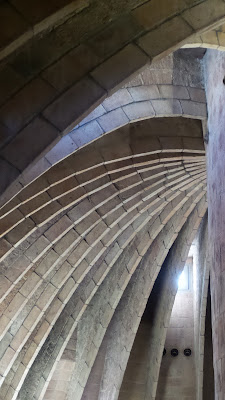Yesterday we went inside.
Back in the day, you'd drive your car through this gate to the underground parking.
Once inside, you'd be much more likely to use the elevators than the steps, though the building does have magnificent stairways.
What I'd call the second floor, in Spain is called the first floor. That's where the owners of the building lived. The rest of the building was partitioned into apartments.
Here's a typical apartment.
Gaudi believed that creating a building meant more than the architecture. He was involved in the design of everything, including floors, furniture, and even hardware fixtures like door pulls.
The door pull above was designed using clay molded to be comfortable to the hand.
Most of the ceilings are sculpted, which makes the room light more interesting.
It's amazing to me that La Pedrera has no load-bearing walls. It's supported by columns and beams.
This makes the internal layout very flexible, and allows a large open space in the middle of the building for light and ventilation.
Above the apartments is the attic. I have an image of what an attic looks like, but Gaudi's attic is a bit different.
It's made from arches, 270 of them. They're called catenary arches. If you suspend a rope from both sides and let it hang down naturally, that's the shape of a catenary arch. They are strong and can be built from inexpensive materials like brick.
They are also graceful and organic. Gaudi's designs come very directly from nature. Here's the inspiration for this design.
It's the spine of a python.
Here's a model of the entire attic, all 270 arches.
As usual, it's very hard to capture the scale with words and pictures. I wandered just a part of the attic to make this video.
The attic is now a Gaudi museum. There were several groups of schoolkids there.
This model of La Pedrera looks almost like a wedding cake. Any bakers out there looking for a challenge?
Up another flight of steps and we're on the roof. Again, it's like no other roof I've ever seen.
This is wonderland.
None of these structures is purely ornamental. In the photo above, look closely at the column closest to the camera and you can see that it's a ventilation shaft.
All of these sculptures are functional parts of the building.
The shapes and curves of the sculptures match those of the building itself.
Here, Gaudi frames another of his works, Sagrada Familia.
This is Gaudi.
Genius is an overworked term, I think.



























